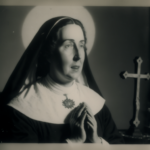
St. Catherine of Siena
St. Catherine of Siena
When She Lived
St. Catherine of Siena was born on March 25, 1347, and she passed away on April 29, 1380.
Where She Lived
Catherine was born and spent most of her life in Siena, a picturesque city in Tuscany, Italy. She was deeply
connected to her hometown and had a significant impact on the religious and political affairs of the region.
Notable World Events During Her Time
- The Black Death (1347-1351): One of the deadliest pandemics in human history, the Black Death, also known as
the Bubonic Plague, swept through Europe during Catherine’s early years. This catastrophic event had profound
socio-economic and cultural consequences, leaving a lasting mark on the collective psyche of the time. - The Hundred Years’ War (1337-1453): This long-lasting conflict between the Kingdom of England and the Kingdom
of France had a significant impact on European politics, diplomacy, and warfare. It influenced alliances, power
dynamics, and the rise of influential leaders, shaping the course of history. - The Western Schism (1378-1417): A major crisis within the Catholic Church, also known as the Papal Schism,
where multiple claimants to the papacy resulted in a split in the allegiance of European nations. This event
profoundly affected the religious and political landscape, leading to debates about authority and the need for
reform. - The Renaissance (14th-17th centuries): A period of profound cultural and intellectual growth, the Renaissance
saw the resurgence of arts, literature, and scientific exploration. It was a time of humanist ideals,
rediscovery of classical works, and the contributions of figures like Leonardo da Vinci and Michelangelo.
Her Patronage
St. Catherine of Siena is the patron saint of a wide range of causes, making her an incredibly versatile and
influential figure in Catholicism. Some of her notable patronages include:
- Against Fire: Catherine is invoked for protection against fire, which could symbolize her
burning devotion and passion for her faith. - Italy: As a prominent Italian saint, she is considered a patron of her home country, reflecting
her profound impact on its spiritual and cultural history. - Nurses: Catherine’s compassion and care for the sick during times of plague have made her a
patron of nurses and healthcare providers, highlighting her dedication to helping others. - The Sick and Suffering: Catherine’s selflessness in tending to those afflicted by disease and
hardship makes her a beloved patron for those facing illness and adversity.
For Christ Alone
St. Catherine of Siena, born Caterina Benincasa, was born in Siena, Italy, on March 25, 1347, to a very large family. At a very young age, Catherine experienced her first vision of Christ. Just a year later, at the age of 7, she is said to have consecrated her virginity to Christ and experienced mystical visions. When she was 12, she told her parents that she did not wish to be married. She wanted to devote her life to God.
However, when her parents tried to force her to marry her sister’s widower, Catherine responded by fasting and cutting her hair in an attempt to make herself as unattractive as possible. Despite Catherine’s religious nature, she did not choose to enter a convent; instead, she joined the Third Order of St. Dominic, which allowed her to associate with a religious society while living at home. At 15, in 1363, Catherine joined the “Mantellate”, a group of Dominican laywomen in Siena. They were devoted to offering service to their neighbors with generosity rather than out of obligation.
Marriage with Christ
Catherine was the first young woman ever to join the Mantellate. All of the other members were widowed, and some did not wish to accept a member at such a young age. Many believed that the Mantellate taught Catherine to read and write. Catherine began to attract people who were drawn by her humility, piety and generosity to the poor.
When she was 21, Catherine had an experience of what she referred to as her “mystical marriage to Christ”. Such a mystical experience changed Catherine’s life. In her vision, she was told to return to public life and to help the sick and the poor. And so, she was moved to immediately pursue her mission. In the process, she attracted followers who helped her serve the poor.
Admonishing the Pope
Her ministry eventually moved beyond the confines of her local community. Catherine began to travel and called for reform of the Church and for people to confess and to love God totally. She involved herself in politics and worked to keep the city states loyal to the Pope.
In 1376, Catherine worked to repair the breach between Pope Gregory XI and a league of northern Italian states led by Florence. Since 1305, the papacy has been a cause of division among the Italians and the French. The conflict with the emperor and the turmoil in Rome forced the popes to retreat to Avignon. It became clear to Catherine that Pope Gregory XI’s return to Rome from Avignon was the only way to bring peace to Italy. Catherine shared the popular Italian desire to restore the papacy to Rome. Pope Gregory XI was willing, but his influential French advisers resisted.
And so, Catherine conducted a campaign of letters to all sides and even offered to mediate directly. She wrote to Pope Gregory XI six times, admonishing him to return to Rome. Encouraged by the people of Florence, Catherine went to Avignon on a peacemaking mission, where she met with Pope Gregory XI. Not long after the encounter, Pope Gregory XI returned the papacy to Rome. Catherine’s efforts to reconcile the pope and the Italian states finally succeeded during the reign of Pope Urban VI, Gregory XI’s successor.

Her Last Years
In the year 1375, Catherine started to dictate letters to scribes. In 1377, Catherine established a monastery for women outside of Siena. She is credited with composing about 380 letters, 26 prayers, and her definitive work, the Dialogue.
Catherine spent the last two years of her life in Rome, in prayer and pleading on behalf of the cause of Pope Urban VI and the unity of the Church. She offered herself as a victim for the Church in its agony. In 1380, Catherine died in Rome at the age of 33. She was canonized by Pope Pius II in 1461. Her feast day is April 29.
5 Interesting Facts About St. Catherine of Siena
- St. Catherine of Siena is the patroness of fire, illness, the United States, Italy, miscarriages, people ridiculed for their faith, sexual temptation, and nurses.
- St. Catherine of Siena is one of only four female Doctors of the Church. The other three are Teresa of Avila, Thérèse of Lisieux, and Hildegard of Bingen. She was conferred this title in 1970 by Pope Paul VI.
- St. Catherine of Siena was made co-patroness of Rome in 1866 by Pope Pius IX, co-patroness of Italy in 1939 by Pope Pius XII, and co-patroness of Europe in 1999 by Pope John Paul II.
- St. Catherine of Siena was so joyful as a child that her family called her “Euphrosyne,” Greek for “joy.”
- In 1375, St. Catherine of Siena received the stigmata, which, according to the biography written by her confessor, was only visible to herself per her request to God.
Prayer to St. Catherine of Siena
O God, who set Saint Catherine of Siena on fire with divine love in her contemplation of the Lord’s Passion and her service of your Church, grant, through her intercession, that your people, participating in the mystery of Christ, may ever exult in the revelation of his glory. Who lives and reigns with you in the unity of the Holy Spirit, one God, for ever and ever. Amen.



